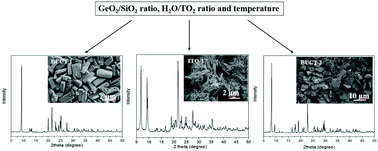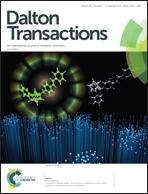Synthesis and characterization of germanosilicate molecular sieves: GeO2/SiO2 ratio, H2O/TO2 ratio and temperature†
Abstract
Many synthesis parameters can influence zeolite crystallization, which include the molar ratio of reagents, water content, temperature, the selection of extraframework cations (organic or inorganic template) and so on. In this paper, two new materials, BUCT-1 with cuboid morphology and BUCT-2 with plate-like morphology were obtained based on the synthesis conditions of ITQ-17 by adjusting the GeO2/SiO2 ratio, H2O/TO2 ratio and temperature. The influence of the three factors on crystal size, crystallinity and phase selection and transformation was carefully discussed. Therein, phase selection and transformation is determined by their synergistic effects; while the influence on crystal size and crystallinity is different for different materials, which is caused by the differences in their structure, or in other words, the building unit, and chemical composition. In addition, the structure of BUCT-2 has already been solved as the stacking of sti layers, and it was identified as pure germanate molecular sieves. Meanwhile, through the characterization of XRD, ICP-AES, IR and STA, some topological information on BUCT-1, such as unit cell parameters, pore size and connectivity, was predicted and the work to present its final structure is still going on.



 Please wait while we load your content...
Please wait while we load your content...